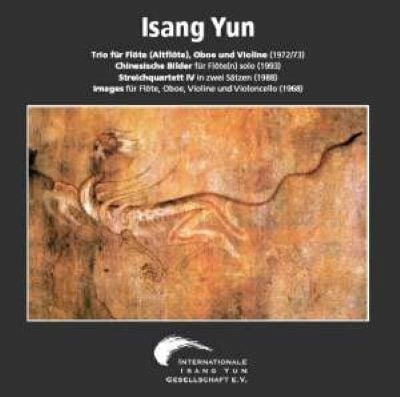Bote & Bock
The String Quartet IV (1988) in two movements was composed for the 65th birthday of a close friend: "for Günter Freudenberg in friendship, for September 16, 1988". Yun, who celebrated his 71st birthday one day later, had been on friendly terms with the German philosopher since the early 1960s because of their common efforts toward Korea's democratisation and reunification. The first movement, which lasts a good ten minutes, demonstrates the active Yang principle and was referred to by the composer as "long and current, a sort of life history". By contrast, the "very humane" (Yun) second movement reveals the other, more introvert side. In an almost seamless dramatic process woven from the small and smallest of elements, the first movement advances toward the quiet and sparing sound of the slow movement like an extended colon rendered in music.
The string quartet begins with a slow introduction of 13 bars and employs a compositional tone seldomly used by Yun: an "as if" tone, which recalls the aura of the classical-romantic compositional style. By opening with the violoncello, the composer's instrument, and by employing the tone F (Freudenberg), Yun alludes to their friendship. Within the first four bars this pitch is developed harmonically and even melodically in the cadential sequence F-Bb7-F7-Bb7, symbolising the experience of young listeners. Yet, at the same time, Yun distorts and expands the tonally unambiguous when, for instance, he alters the fifth of the aforementioned chord to f-sharp.
In the following bars Yun immerses himself completely in his own unique idiom. The lower strings play in a relatively high register, presenting new material in the form of trills, triplets and glissandi. A "flexible", agile solo of the first violin subsequently attacks the "stiff" chordal framework of the other strings.
Yun, who did not merely compose "notes", but rather sound as language, initiates a rivalry-like "working out" of energies in musical space, in which changing combinations – predominantly grouped in pairs – are swept along in a wave-like process. Powerful sound formations strike up repeatedly out of the depths and lead upwards with mounting intensity into regions of utmost expressivity and extreme agitation. For instance, a violin duet in the highest registers is answered both in contrast and protest by the double-stop vehemence of the lower strings. Yun presents a veritable compendium of musical gestures and performance techniques. Although the musical process of transformation and development strives with restless movement for harmony and peace, balance and reconciliation are achieved only conditionally by a progressive merging of gesture and instrumental sound. In this respect, a characteristic example is the combination of the so-called "string flowers" – a trilling and gliding texture – with the plucked strings of the violoncello, whose articulation is inspired by the sound of the Korean zither, the komun'go.
Near resignation characterises the opening of the second movement, which begins with a circling, self-contained monologue. As already in the first movement, here too the recitation on a single tone seems to imitate the human heartbeat. A double flageolet (harmonics) in the violins answers the pleading gestures of the cello and the viola. The increase of movement and densification in the middle part is followed by a short reprise-like epilogue. Here, above all in the first violin, those elements of Yun's late style are heard, that appeared even to him to come from a distant tonal world.
Walter-Wolfgang Sparrer (1996)

Quartet 21, Seoul: Hyunmi Kim (1st violin), Sungeun Cho (2nd violin), Chanjoo We (viola), Kyungok Park (cello)
Internationale Isang Yun Gesellschaft IYG 001
